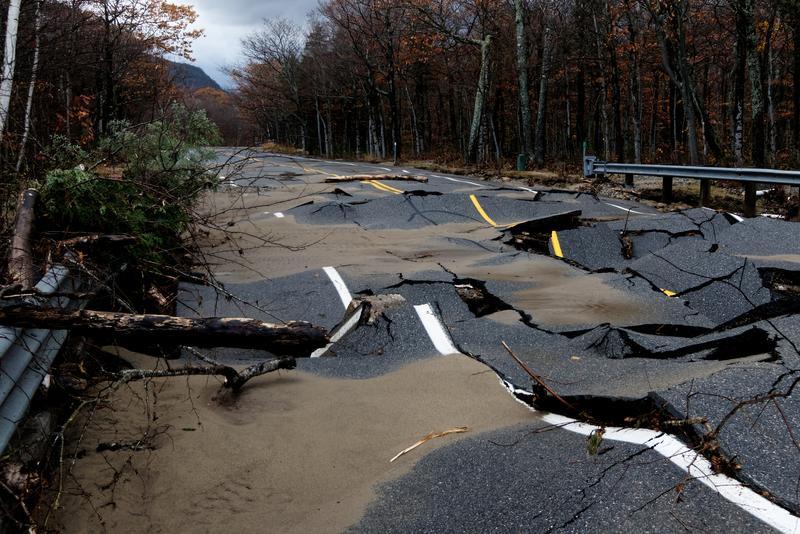Climate Resilience – Infrastructure
As climate change impacts become more severe, cities and communities are seeking to become more resilient. One obvious place to start is infrastructure (roads, bridges, water treatment facilities, etc.) that are designed to last fifty years or more. If we can make our investments in infrastructure resilient to the impacts of climate change, they will increase the likelihood of rapid recovery from extreme events.
Our climate crisis puts us in a race against time: we need to ensure that the billions of dollars invested in infrastructure each year are well spent. Infrastructure investments must fulfill their objectives over their entire design life. Today, engineers typically design infrastructure based on the assumption that past climate is a reliable predictor of future conditions. This assumption no longer holds. Long-lived infrastructure designed using past climate patterns will fail in the future. Climate projections carry uncertainty which creates challenges for infrastructure planners and engineers unaccustomed to managing these ambiguities.
We need to accelerate the pace at which we identify and address climate risks. With each passing year, our infrastructure is increasingly stressed as we try to withstand the impacts. Although governments and the private sector invest billions of dollars in new infrastructure each year, that infrastructure is seldom designed for the effects of sea level rise, storms, floods, droughts, wildfires, and other hazards that our climate crisis is producing.
The pressing demand for infrastructure (and the financing required to realize it) is an enormous challenge. It also provides an enormous opportunity to build a more resilient future. Without significant improvements in infrastructure resilience, annual economic losses from natural disasters’ damage to urban infrastructure alone will increase from $300 billion currently to $415 billion by 2030. https://www.cfr.org/conference-calls/climate-change-resilience
Developing more resilient infrastructure involves a broad range of players. They include bureaucrats, community members, designers, developers, disaster response professionals, engineers, investors and the financial sector, planners, policy makers, researchers and more. All are stakeholders in the long-term viability of infrastructure.
The best existing ideas to achieve resilient infrastructure are not yet in widespread practice. We need to scale up good practices rapidly even as we advance our understanding of infrastructure resilience. Quicker action today can help ensure that current investments are sound and will contribute to a more resilient future.
We need to start today – doing what we can with what we know now. We should include the needs of the more vulnerable members of our communities. We must be inclusive, engaging all stakeholders early and often throughout the entire process. An inclusive process ensures that decisions are grounded in the best available information. Inclusivity also reduces future conflict, avoids unintended consequences, identifies a myriad of options, and increases support for the actions chosen.
Infrastructure is embedded in a complex and interconnected environment and includes natural, built and human systems. There are often strong interdependencies between infrastructure systems. Imagine when a bridge becomes unsafe to use. The impact on the surrounding roads and alternate bridges is significant. That, in turn, affects businesses, commuters and emergency response, ultimately disrupting the well-being of communities. Given the potential for these systemic impacts, it is important to screen for risks at a systems level rather than looking only at individual assets. Systems thinking provides more opportunities to achieve broad benefits and avoid maladaptation. This approach will require changes in policies, advances in science and technology, and new practices by policy makers, practitioners and investors.
Working under uncertainty requires flexibility allowing us to change course on the fly as new information becomes available. Designers can preserve options that may not seem justified or affordable today, but could be important later as conditions change. Explicitly accounting for uncertainty in project design can lead to better decisions.
Decisions around land use planning and zoning are crucial. Considering where to build as well as how to build can reduce risks to individual assets. Nature-based infrastructure complements conventional infrastructure. It reduces risks, enhances resilience, and supports other objectives including ecosystem restoration, protection of green space and carbon sequestration. On its own, green infrastructure reduces risks from some hazards. For example, mangroves protect coasts from storm surge and erosion, in addition to providing benefits such as breeding grounds for fish.
A combination of nature-based and conventional infrastructure increases overall resilience. This combined approach provides redundancy. For example, during a severe storm, healthy wetlands can reduce the impacts of storm surge on coastal communities, reduce strain on constructed storm drainage systems, and mitigate the risk of flooding and damage to buildings and roads. Natural and man-made infrastructure solutions respond differently to a range of hazards, thereby increasing resilience through complementary adaptation responses.
Policy makers should create visions for a resilient future that can be pursued incrementally, while also building blueprints for broader transformation should a disaster occur. The latter may involve moving people, assets, and infrastructure out of harm’s way rather than rebuilding in high-risk areas.
The gap between current expenditures and investment needs is massive. Achieving climate resilient infrastructure at the scale necessary to narrow this gap will require mobilization of both public and private finance. For example, New York City and the US Federal Emergency Management Agency (FEMA) are using government-funded infrastructure investments to promote “beyond code” compliance, meaning that they are raising standards above the minimum requirements of local building codes.
Often, however, federal, state and local governments do just the opposite, encouraging risky behaviors, such as rebuilding in flood zones after a disaster. There is a need, particularly in the short term, to incent investments (e.g., resilience tax credits, loans, grants, etc.) to accelerate financing for resilience.


